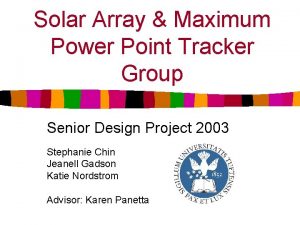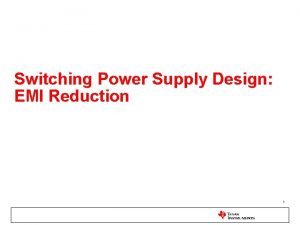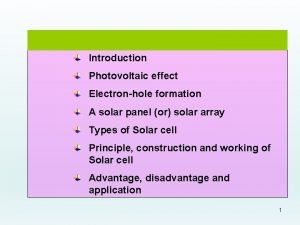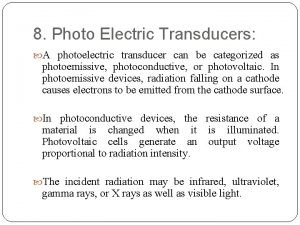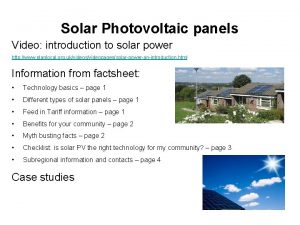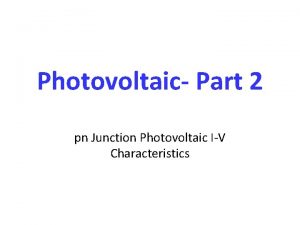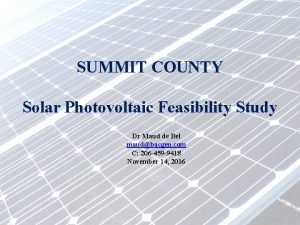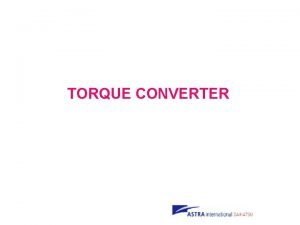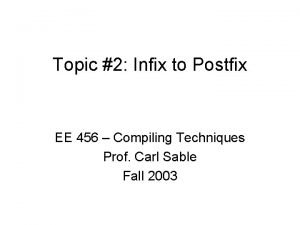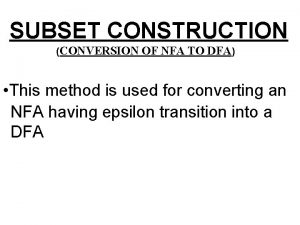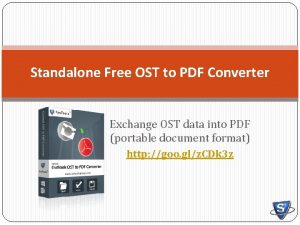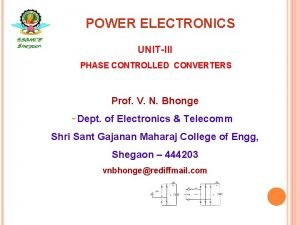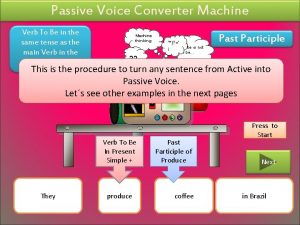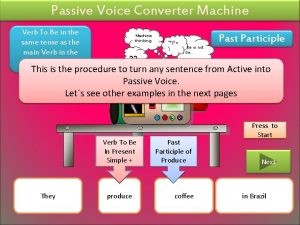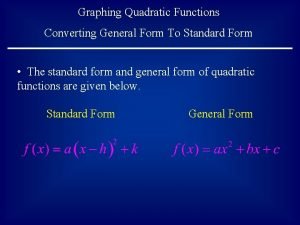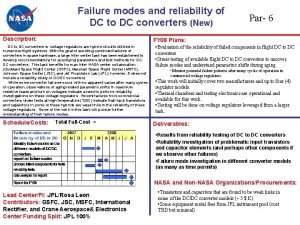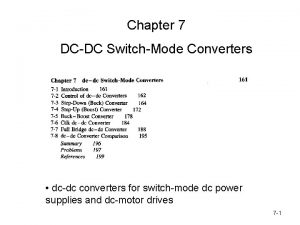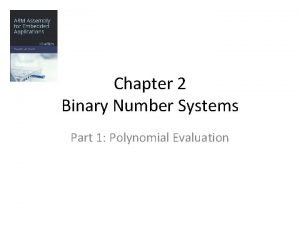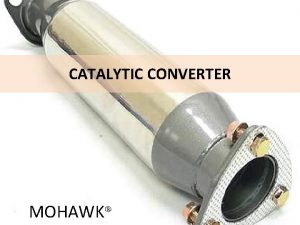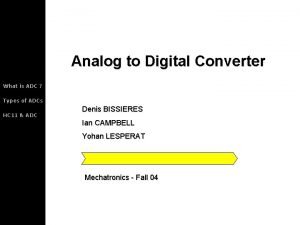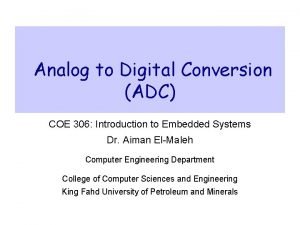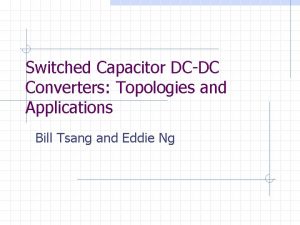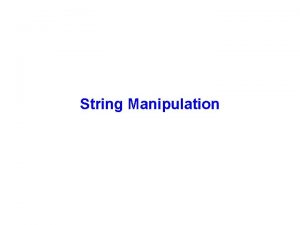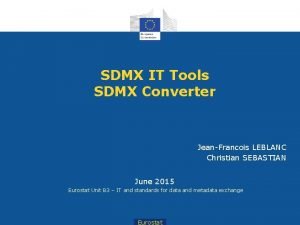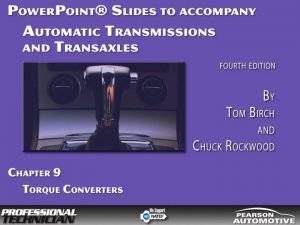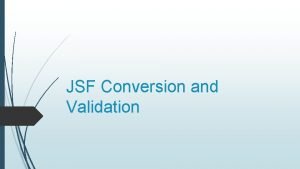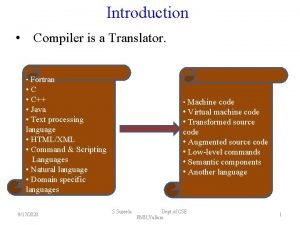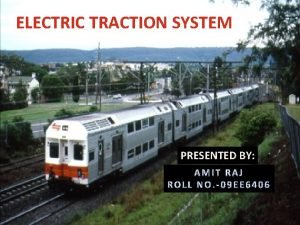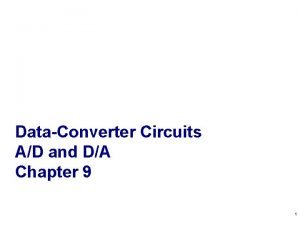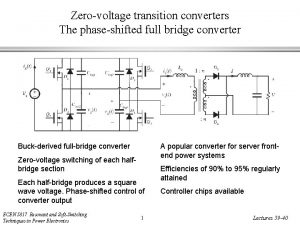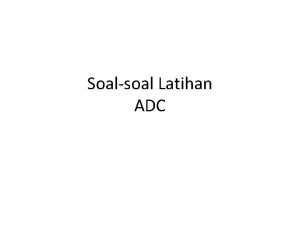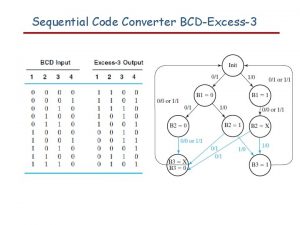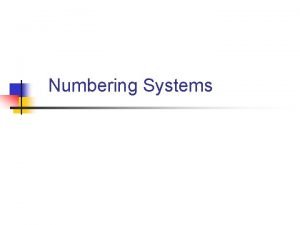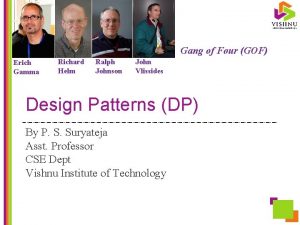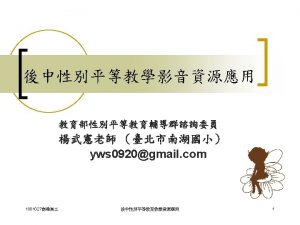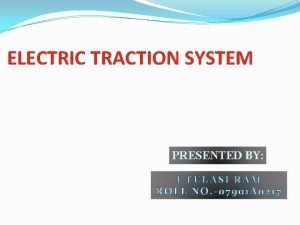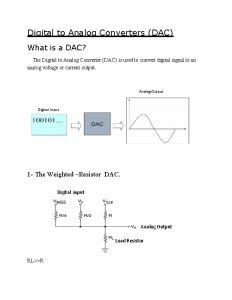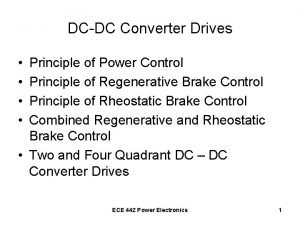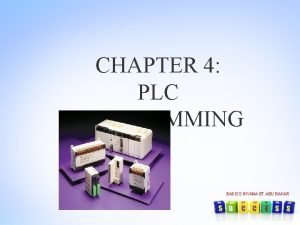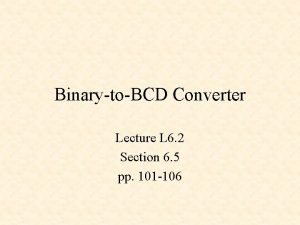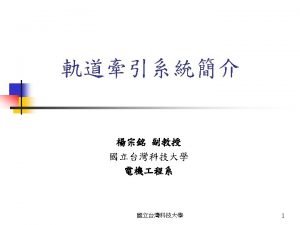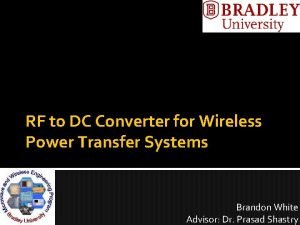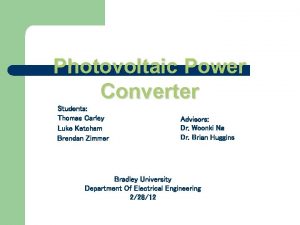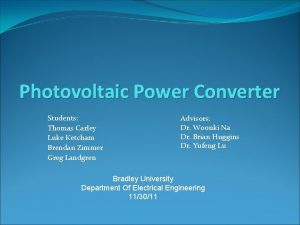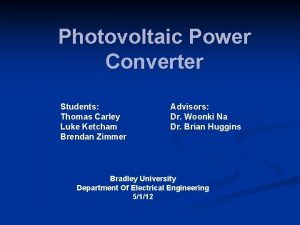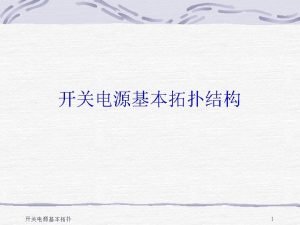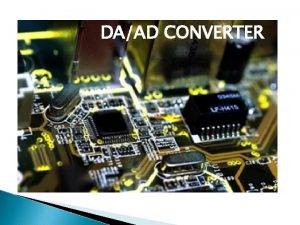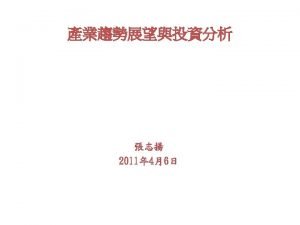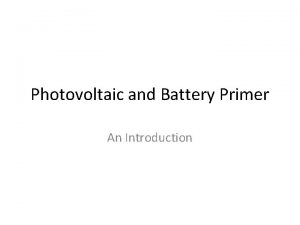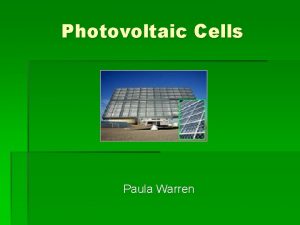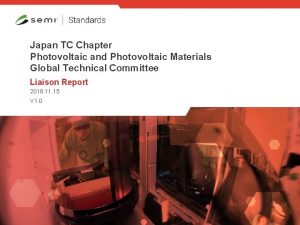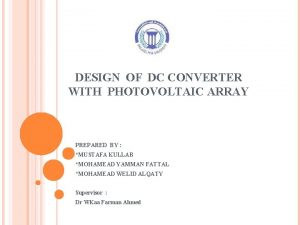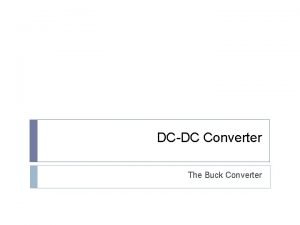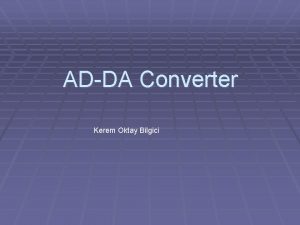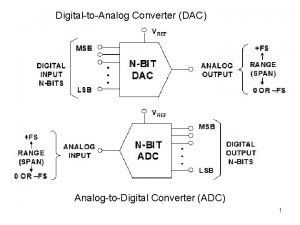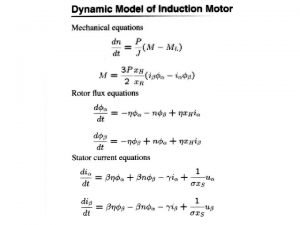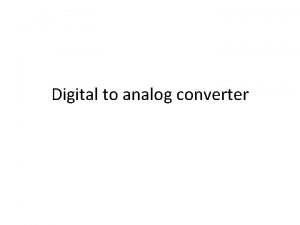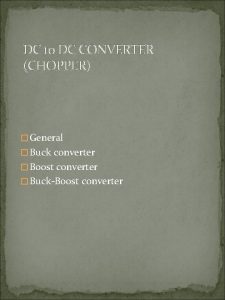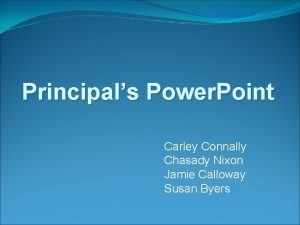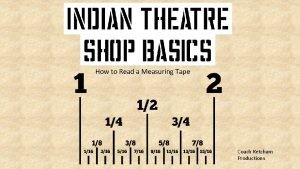Photovoltaic Power Converter Students Thomas Carley Luke Ketcham

































































- Slides: 65

Photovoltaic Power Converter Students: Thomas Carley Luke Ketcham Brendan Zimmer Advisors: Dr. Woonki Na Dr. Brian Huggins Bradley University Department Of Electrical Engineering 5/1/12

Presentation Outline n Project Summary n Project Motivation n Overall System Block Diagram n Boost Converter n Inverter n Future Work 2

Project Summary n Photovoltaic Array n Supplies DC and AC Power n Boost Converter to step up PV voltage n Maximum Power Point Tracking n DC-AC converter for 120 Vrms 60 Hz n LC filter 3

Project Motivation Power Electronics n Alternative Energy Sources n Useful Applications n ¨ Household grid-tie inverter ¨ Electric drives 4

System Block Diagram 5

BP 350 J PV Panel n n n Pmax = 50 W Voltage at Pmax = 17. 5 V Current at Pmax = 2. 9 A Nominal Voltage = 12 V Isc = 3. 2 A Voc = 21. 8 V 6

DC Subsystem Requirements n The boost converter shall accept a voltage from the photovoltaic cells. ¨ The n input voltage shall be 48 Volts. average output shall be 200 Volts +/- 25 Volts. The voltage ripple shall be less than 20 Volts ¨ The open-loop boost converter shall operate above 65% efficiency. n The boost converter shall perform maximum power point tracking. ¨ The PWM of the boost converter shall be regulated based on current and voltage from the PV array. ¨ The efficiency of the MPPT system shall be above 80%. 7

Boost Converter Test Boost Converter 20 V to 66 V D =. 3 8

Boost Converter Design 9

Hardware 10

Key Components n MOSFET (IRFP 4768 Pb. F) ¨ VDSS n = 250 V Id = 93 A Ultrafast Diode (HFA 50 PA 60 C) ¨ VR = 600 V If = 25 A Trr = 50 ns Inductors (3 m. H) n Capacitors (6000 u. F) n 11

Gate Driver n IR 2110 12

Boost Converter Simulations Output Voltage (V) 20 V – 66 V 13

Boost Converter Simulations Boost Converter Current (A) 20 V-66 V 14

Boost Converter Testing 10 V to 16. 5 V 40% Duty Cycle Output Voltage Inductor Current 15

Eliminating Voltage Spikes Parasitic capacitance and inductance n Diode forward recovery time n Circuit Layout n Add Gate Resistor to increase turn-on and turn-off time n Add RC snubber n 16

Increasing Turn off Time Turn off time increased from 92 ns to 312 ns 17

Determining RC snubber values 18

Reducing Voltage Spikes 20 V to 66 V Without Gate Resistor And RC Snubber 70% duty With Gate Resistor And RC Snubber 19

Boost Converter Current Efficiency = 60. 7% Without RC snubber and Gate Resistor Efficiency = 58. 1% With RC snubber and Gate Resistor 20

Future Work For Boost Converter Optimize inductor value n Printed Circuit Board Layout n Optimize RC snubber values n Test with multiple solar panels n 21

Maximum Power Point Tracking (MPPT) n n n Every PV has a V-I and P-V curve for a given insolation and temperature The MPP is seen clearly from the P-V curve Anytime the system is not at the MPP, it is not at it’s most efficient point I V MPP P V 22

Perturb and Observe (P&O) Slight voltage perturbation n Observation of: n ¨ Change in PV power ¨ Change in boost converter duty cycle n Make an increase or decrease in boost converter duty cycle based on observation 23


MPPT Algorithm Comparison n Perturb and Observe ¨ Pros: n Very popular n Simple to implement ¨ Con: n Power loss from perturbation n Incremental Conductance ¨ Pro: n Tracks a rapidly changing MPP ¨ Cons: n Increased complexity n Increased susceptibility to noise 25

Implementing MPPT Spectrum Digital e. Zdsp F 2812 n Voltage Sensing n Current Sensing n Matlab Simulink Modeling with Code Composer Studio n 26

e. Zdsp F 2812 features n n n n Texas Instruments TMS 320 F 2812 chip 32 -bit DSP Core – 150 MIPS 18 K + 64 K RAM 128 K Flash 30 MHz clock 12 PWM outputs 16 ADC 12 bit inputs ¨ 60 ns conversion time 27

Voltage Sensing Vpv is 0 to 24 V n VADC 0 to 3. 3 V n 28

Current Sensing n Ipv: 0 to 50 A n Vout: 0 to 4 V 29

Simulink Model P&O n ADC measurement Voltage and current every 100μs ¨ Mean value with running window of 1 Hz ¨ 30

Simulink Model Soft Start 31

MPPT and Soft Start Results n Soft start duty cycle control ¨ 0% to 30% ¨ 5% increase every 5 seconds ¨ Transition to MPPT after 40 seconds n MPPT duty cycle control ¨ ADC measurements n Voltage and current every 100μs n Mean value with running window of 1 Hz ¨ 1% increase/decrease every 1 second 32

Power Supplies 120 Vrms 60 Hz input from wall n 15 V, and 3. 3 V output n Consists of Transformer, Diode Rectifier, 470 u. F capacitor, and voltage regulators n Needed for Gate Drivers, Op Amps, Sensing ICs, and other logic devices n 33

Power Supply Transformer (3 FL 20 -125) • Secondary Voltage of 10 VAC • Secondary Current of 0. 25 A RMS 34

Power Supply 35

AC Subsystem Overview 36

AC Subsystem Goals DC power to AC power n AC power quality n 37

AC Subsystem Requirements n The AC side of the system shall invert the output of the boost converter. ¨ The output of the inverter shall be AC voltage. ¨ The output shall be 60 Hz +/- 0. 1 Hz. n The inverter output shall be filtered by a LC filter. ¨ The filter shall remove high switching frequency harmonics. ¨ Total harmonic distortion of the output shall be less than 15%. 38

Topology - Inverter Single-phase bridge inverter 39

Switching Logic n Desire to control ¨ Output frequency ¨ Output magnitude Sinusoidal PWM! 40

Theory of Sinusoidal (Bipolar) PWM n n n The magnitude of a triangle carrier signal is compared to a sinusoidal reference If Vreference > Vcarrier PWM = high If Vreference < Vcarrier PWM = low A complementary signal drives opposite leg of H-bridge 41

Unipolar Sinusoidal PWM Two sinusoids compared to a triangle reference n Each comparison drives one H-bridge leg respectively n 42

Unipolar PWM in Action n n Two comparisons Each leg of H-bridge driven independently 3 -level output Less harmonic distortion than bipolar PWM 43

Design Equations n Modulation index, mi n Fundamental Output Magnitude n Frequency Modulation ratio, mf n Output Frequency 44

Implications n mi can be used to control output magnitude (voltage) n Typically 0 < mi ≤ 1 Overmodulation if mi > 1 (non -linear operation) ¨ Useful for obtaining large output power, but harmonic distortion will be large n 45

Implications n Output Frequency n Can select mf to remove even harmonics from output spectrum ¨ For Bipolar PWM, mf = odd integer ¨ For Unipolar PWM, mf = even integer Example (Unipolar): fcarrier = 60 Hz ftriangle = 2520 Hz mf = 42 46

Output n Desire sinusoidal output ¨ Output isn’t very sinusoidal n Use a filter ¨ LC filter 47

LC Filter n n n Goal: Smooth inverter output to smooth AC Second order LC filter transfer function: G(s) = 1/(L*C*s^2+1) fcarrier < cutoff frequency < fcarrier ∙ mf 48

Simulation n PSIM, Circuit Simulation Software ¨ Proof of concept simulations Bipolar PWM vs. Unipolar PWM n Effectiveness of LC filter with both schemes n 49

PSIM Schematic (Bipolar PWM) mi = 0. 8 mf = 11 Vd = 200 V 50

PSIM Schematic (Unipolar PWM) mi = 0. 8 mf = 10 Vd = 200 V 51

Simulation Result – Vout (unfiltered) Bipolar PWM Unipolar PWM 52

Simulation Results (filtered) Bipolar PWM Unipolar PWM fout = 60 Hz (both cases) 53

Bipolar PWM – Frequency Domain Unfiltered Output Filtered Output mi = 0. 8 mf = 81 54

Unipolar PWM – Frequency Domain Unfiltered Output Filtered Output mi = 0. 8 mf = 80 55

Implementation Major Hardware Components IGBT n Gate Drive n LC Filter n Spectrum Digital e. Zdsp F 2812 n ¨ Texas Instruments TMS 320 F 2812 ¨ Simulink, Code Composer Studio 56

IGBT n International Rectifier IRG 4 PC 30 UDPb. F ¨ VCEmax = 600 V ¨ fswitching max = 40 k. Hz ¨ ICmax = 12 A ¨ Cost = $2 -3 each 57

Gate Drive n International Rectifier IR 2110 ¨ Drives Two IGBTs/MOSFETs ¨ Cost $3 each 58

LC Filter L = 1 m. H C = 100 μF Cost of components = $6 fcutoff ≈ 500 Hz 59

Sinusoidal PWM – Simulink 60

Experimental Results Bipolar PWM Vd = 10 V (DC) Vout = 13. 6 V (AC) mi=0. 8 mf = 83 61

Future Work Closed-loop MPPT control with PV input n Inverter voltage and current controller n Tying the inverter to the grid n ¨ Phase Locked Loop (PLL) 62

Special thanks to: Dr. In Soo Ahn Mr. Steve Gutschlag 63

References n n n PV Module Simulink Models. ” ECEN 2060. University of Colorado Boulder. Rozenblat, Lazar. "A Grid Tie Inverter for Solar Systems. " Grid Tie Inverter Schematic and Principles of Operation. 6 Oct. 2011. <http: //solar. smps. us/grid-tie-inverter-schematic. html>. Tafticht, T. , K. Agbossou, M. Doumbia, and A. Cheriti. "An Improved Maximum Power Point Tracking Method for Photovoltaic Systems. " Renewable Energy 33. 7 (2008): 1508 -516. Tian, Yi. ANALYSIS, SIMULATION AND DSP BASED IMPLEMENTATION OF ASYMMETRIC THREE-LEVEL SINGLE-PHASE INVERTER IN SOLAR POWER SYSTEM. Thesis. Florida State University, 2007. Zhou, Lining. EVALUATION AND DSP BASED IMPLEMENTATION OF PWM APPROACHES FOR SINGLE-PHASE DC-AC CONVERTERS. Thesis. Florida State University, 2005. 64

Questions? 65
 Photovoltaic array maximum power point tracking array
Photovoltaic array maximum power point tracking array Buck converter and boost converter
Buck converter and boost converter Brad henning
Brad henning Carley matthews
Carley matthews Photovoltaic effects
Photovoltaic effects Photoemissive photoconductive and photovoltaic
Photoemissive photoconductive and photovoltaic Photovoltaic video
Photovoltaic video Wholesale solar cell battery
Wholesale solar cell battery Photovoltaic
Photovoltaic Solar leasing summit county
Solar leasing summit county Real power and reactive power
Real power and reactive power Rizal participated in the student demonstration in madrid
Rizal participated in the student demonstration in madrid Thomas mocker and thomas stewart
Thomas mocker and thomas stewart Microsoft virtual machine converter download
Microsoft virtual machine converter download Igel desktop converter
Igel desktop converter Fungsi torque converter
Fungsi torque converter Ee-456
Ee-456 Subset construction method to convert nfa to dfa
Subset construction method to convert nfa to dfa Ost to pdf converter
Ost to pdf converter Semi converter operates in which quadrant
Semi converter operates in which quadrant Apa itu bcd
Apa itu bcd Passive voice machine
Passive voice machine Past passive converter
Past passive converter Rules of boolean algebra
Rules of boolean algebra Converting general form to standard form quadratic
Converting general form to standard form quadratic Vrmat
Vrmat Dc-dc converter failure modes
Dc-dc converter failure modes Single phase dual converter waveform
Single phase dual converter waveform Catalytic converter reaction mechanism
Catalytic converter reaction mechanism Switch mode converter
Switch mode converter Buck converter output voltage
Buck converter output voltage Two's complement representation
Two's complement representation Catalytic converter ingredients
Catalytic converter ingredients Antaira media converter
Antaira media converter Types of analog to digital converters
Types of analog to digital converters Single slope adc
Single slope adc Aub letter grades conversion
Aub letter grades conversion Apa kepanjangan dari adc
Apa kepanjangan dari adc Cbc converter hdmf
Cbc converter hdmf Charge pump converter
Charge pump converter Java string manipulation
Java string manipulation Sdmx converter
Sdmx converter What is vortex flow in a torque converter
What is vortex flow in a torque converter Opensim oar files
Opensim oar files Jsf number converter
Jsf number converter Csepmu
Csepmu Halo closed bag adaptor
Halo closed bag adaptor Exponent mantissa
Exponent mantissa Arno converter is
Arno converter is Ytm5 converter
Ytm5 converter D/a converter
D/a converter Buck converters
Buck converters Rumus adc
Rumus adc State diagram to state table converter
State diagram to state table converter Decimal to binary converter
Decimal to binary converter Image to text converter
Image to text converter Www freemake com
Www freemake com Arno converter converts
Arno converter converts Digital to analog converter
Digital to analog converter Rheostatic brake
Rheostatic brake Ladder diagram to mnemonic code converter
Ladder diagram to mnemonic code converter 8 bit binary to bcd converter circuit
8 bit binary to bcd converter circuit Adc
Adc Readhesion
Readhesion Langauge converter
Langauge converter Rf to dc converter
Rf to dc converter
